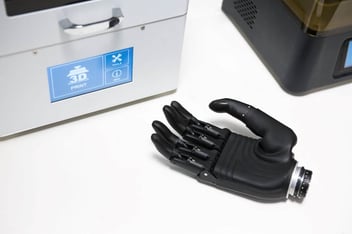FAQs About Bionic Hands: Answered
Whether you’re looking for your first prosthetic hand or you’ve been using prostheses for years, many patients have questions about bionic hands. After all, bionic hands are relatively new to the prosthetic market, and with such advanced technology, patients are curious about how they work.
For this reason, we’ve compiled a list of frequently asked questions regarding bionic hands. With these answers, you’ll have all the information you need to become a bionic hand user.
How do bionic hands work?
One of the most common questions regarding bionic hands is how they work. It’s widely understood that using a bionic hand, users can control their hand and fingers using precise movements and grips. But, with only electrodes placed on the users’ residual limb, it can seem as though it’s powered by mind control. While a seemingly comical assumption, many users are surprised as to how bionic hands work.
Bionic hands use bio-signal processing to control hand movements. The bionic hand device is equipped with advanced sensors that pick up electromyographic (EMG) signals. These signals are emitted by the patient’s nerves and muscles each time they flex, as they would when moving a natural hand or finger. By placing electrodes on the surface of the patient’s skin, it begins to look for these signals. Consequently, the bionic hand behaves just like a natural limb when signals are received.
So, while it may seem as though bionic hands are controlled by the user’s mind, it’s actually just the device picking up on nerve signals from the patient’s body. Thankfully, advanced technology has made it possible that even with only a weak output or reception of signals, operating a bionic hand is still possible.
As the bionic hand operates using patients’ nerve signals, operating it is extremely intuitive. Consequently, patients can quickly learn how to use their bionic hand and become comfortable doing so. With such high functionality, users are able to perform a variety of activities and day-to-day functions, as well as transition between heavy and fragile objects.
What’s the difference between bionic hands and other prosthetic hands?
Another common question received by patients is the difference between a bionic hand and other types of prosthetic hands. There are a few different types of prosthetic hands that a user can choose from, including:
-
Passive: Passive prostheses mimic only the appearance of a hand for aesthetic purposes and do not have powered parts.
-
Active: Enable users to perform different motions through external power sources or the patient’s body. Different types of active prosthetic hands include:
-
Body-powered: Controlled by the patient’s movements, similar to a pulley system. Using a strap cable attachment, patients can adjust and move the prosthesis using other parts of their body.
-
Externally-powered: Controlled by a patient’s nerve signals and an external device, meaning that bionic hands fall under this category.
-
Hybrid-powered: Combination of the previous two types of hands. These hands are most often recommended to patients with extensive limb loss as they require multiple moveable components to operate their prostheses.
-
Activity-specific: Designed for specific vocational activities such as swimming or playing sports. Hands in this category will differ based on the activity in question.
-
What happens if I damage the hand?
Even patients who have not used a bionic hand recognize that it is a piece of technology. Consequently, they may worry about damaging their hand and what happens if they do.
Fortunately, this exact concern is anticipated in the design of the Zeus, our bionic hand. The Zeus is made of highly durable materials and flexible, damage-resistant fingers. As such, the Zeus can withstand casual bumps and bruises without breaking.
But, should a user’s bionic hand be damaged, not to worry - it can be repaired! If you’re an experienced bionic hand user, you may be thinking, “yeah, but how long will it take?” Fortunately, the Zeus is locally repairable, which means it can be repaired on-site with a user’s local prosthetist.
This means that repairs can be made within one hour, rather than several days like other bionic hands may require. Plus, with remote configuration, small technical changes and adjustments can be made from any location - no wait required.
Will my bionic hand look like my “real” hand?
While there are many prosthetic hands designed to mimic the appearance of a natural hand, that isn’t the intention of the bionic hand. Bionic hands such as the Zeus are an advanced piece of technology, and they look as such. With unprecedented strength and dexterity, many users feel as though their bionic hand makes them a superhero, and it can make them look that way as well.
Can I get my bionic hand wet?
As with your phone, laptop, or any other piece of technology, bionic hands should not be exposed to large amounts of water. While it can withstand some rain or a small splash, for optimal functionality and the longevity of your bionic hand, it should be kept dry.
Is a bionic hand expensive?
While there is no shortage of patient interest in bionic hands, many fear that they won’t be able to afford it. While some bionic hands are of the high price range, we wanted the Zeus to be accessible to all, which means affordable to all as well. Thanks to developments in 3D printing and our mission to make a bionic hand for all, the Zeus is an affordable bionic hand, ensuring that patients of all backgrounds get the chance to become a Zeus user.
Additionally, as the Zeus is now officially PDAC approved under L6880, it is covered by Medicare. Consequently, any patient with Medicare can get the Zeus more affordable than ever.
With these questions answered, we hope that patients will feel confident to take the next step toward becoming a Zeus user. If you’re interested in learning more about our bionic hand, the Zeus, book a demo.











